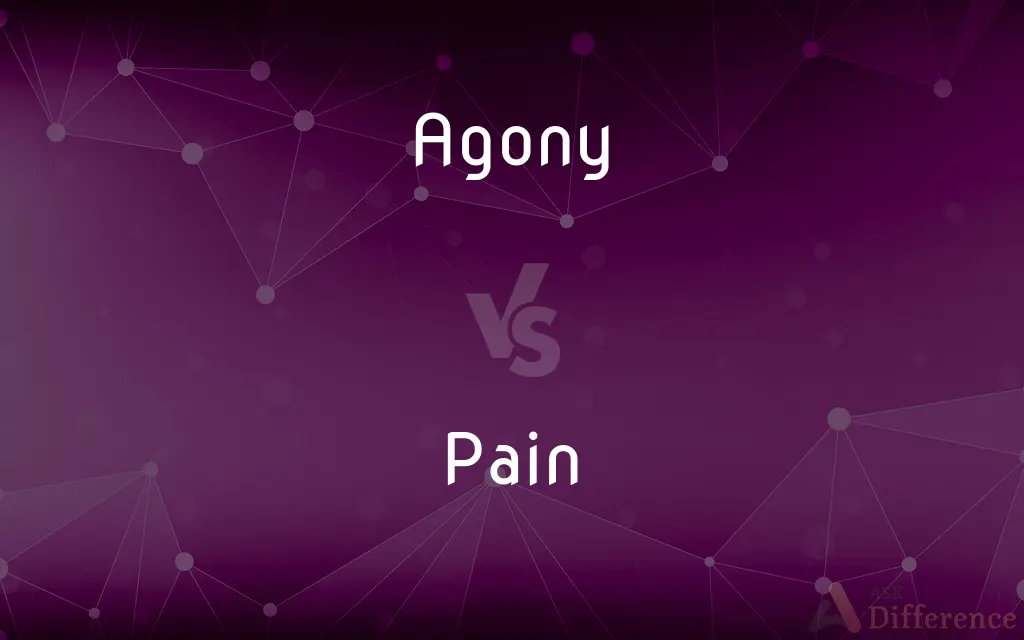Agony vs. Pain — What's the Difference?
By Tayyaba Rehman & Urooj Arif — Updated on March 5, 2024
Agony is an intense feeling of suffering, often encompassing both physical and emotional distress, while pain is a discomfort or unpleasant sensation typically resulting from injury or illness.

Difference Between Agony and Pain
Table of Contents
ADVERTISEMENT
Key Differences
Agony extends beyond the physical aspect to include profound emotional or psychological distress, often reflecting a state of extreme suffering or torment. It can arise from severe physical pain, emotional loss, or existential despair, highlighting its multifaceted nature. On the other hand, pain is primarily recognized as a physical sensation signaling harm or potential injury to the body. It serves as a crucial biological warning system, indicating when something is wrong and potentially preventing further damage.
The experience of agony often encompasses a deeper, more overwhelming sense of distress that can be paralyzing or all-consuming. It is used to describe situations or feelings of severe suffering, where the intensity and scope exceed ordinary pain. Whereas pain, whether acute or chronic, refers to a specific and identifiable sensation of discomfort, ranging from mild to severe, but is usually confined to the physical realm.
Agony is subjective and can be influenced by various factors, including emotional state, psychological conditions, and personal tolerance to distress. It often requires a comprehensive approach for relief, addressing both the mind and body. Pain, while also subjective, is more directly linked to physical conditions and can often be measured or evaluated through clinical methods, making its management more straightforward in many cases.
Agony is often associated with scenarios of extreme hardship or emotional turmoil, conveying a sense of profound despair or suffering. This contrasts with pain, which is more commonly related to physical injuries, diseases, or conditions, emphasizing the sensorial and bodily aspect of discomfort.
Both agony and pain play significant roles in human experience, signaling when attention and care are needed. However, their management and implications differ: treating pain often focuses on the physical causes and alleviating symptoms, while addressing agony may require a more holistic approach, considering emotional and psychological support alongside physical remedies.
ADVERTISEMENT
Comparison Chart
Nature
Intense suffering encompassing physical and emotional distress
Discomfort or unpleasant sensation primarily physical
Scope
Extensive, can be both physical and emotional
Usually confined to physical sensations
Indicators
Severe distress, existential despair, overwhelming torment
Injury, illness, or bodily harm
Management
Requires holistic approach (physical, emotional, psychological)
Primarily focuses on physical causes and symptoms relief
Common Associations
Extreme hardship, emotional turmoil, despair
Physical injuries, diseases, conditions
Compare with Definitions
Agony
Extreme suffering that encompasses both physical pain and emotional distress.
The loss of her child plunged her into deep agony.
Pain
Discomfort associated with injury, illness, or physical strain.
The medication helped alleviate her chronic pain.
Agony
A state of intense discomfort or torment, often beyond mere physical pain.
His final moments were filled with agony.
Pain
An unpleasant sensation signaling potential or actual harm to the body.
He felt a sharp pain in his leg after the fall.
Agony
An overwhelming feeling of despair or distress.
The agony of defeat was harder to bear than physical pain.
Pain
A symptom of underlying health issues, often signaling the need for medical attention.
Sudden chest pain prompted him to visit the doctor.
Agony
The profound sense of suffering associated with severe mental or emotional distress.
She experienced agony in the face of betrayal.
Pain
A specific and identifiable sensation of physical discomfort.
The dentist worked carefully to minimize pain during the procedure.
Agony
The term used to describe situations of extreme hardship or emotional suffering.
The novel captures the agony of war and loss.
Pain
A bodily sensation that varies in intensity, from mild discomfort to severe distress.
Managing pain after surgery is crucial for recovery.
Agony
An instance of such suffering
The agonies of adolescence.
Pain
Pain is a distressing feeling often caused by intense or damaging stimuli. The International Association for the Study of Pain defines pain as "an unpleasant sensory and emotional experience associated with, or resembling that associated with, actual or potential tissue damage." In medical diagnosis, pain is regarded as a symptom of an underlying condition.
Agony
Intense feelings of suffering; acute mental or physical pain;
An agony of doubt
The torments of the damned
Pain
Highly unpleasant physical sensation caused by illness or injury
She's in great pain
Chest pains
Agony
A state of acute pain
Pain
Great care or trouble
She took pains to see that everyone ate well
Pain
Emotional distress; a fundamental feeling that people try to avoid;
The pain of loneliness
Pain
A somatic sensation of acute discomfort;
As the intensity increased the sensation changed from tickle to pain
Pain
Cause bodily suffering to
Pain
Cause emotional anguish or make miserable;
It pains me to see my children not being taught well in school
Common Curiosities
What is agony?
Agony is an intense state of suffering that encompasses both physical pain and emotional distress, reflecting extreme discomfort or torment.
Is agony always related to physical pain?
Not always. Agony can stem from purely emotional or psychological sources, such as grief or existential despair, without physical pain.
Can pain be treated without medication?
Yes, pain management can include non-pharmacological methods such as physical therapy, acupuncture, relaxation techniques, and psychological support.
What is pain?
Pain is an unpleasant sensory and emotional experience associated with actual or potential tissue damage, signaling harm or injury to the body.
How do agony and pain differ?
Agony refers to profound suffering that can include emotional distress, whereas pain primarily denotes physical discomfort or unpleasant sensations.
Can emotional experiences cause physical pain?
Yes, intense emotional experiences can manifest as physical pain, illustrating the interconnectedness of psychological and physiological responses.
What role does agony play in the human experience?
Agony, while distressing, can be a profound aspect of the human experience, shaping personal growth, resilience, and empathy towards others.
How can someone support a loved one in agony?
Support can include offering a listening ear, providing emotional and psychological support, and encouraging professional help when necessary.
How does society view agony and pain?
Society's view varies, but there's a growing recognition of the importance of addressing both physical and emotional aspects of suffering for holistic well-being.
How is pain measured?
Pain is often measured using scales, such as the numerical rating scale or visual analog scale, allowing individuals to rate their pain intensity.
Why is it important to address both physical and emotional aspects of suffering?
Addressing both aspects is crucial for comprehensive care and healing, as emotional well-being significantly impacts physical health and recovery.
Is chronic pain the same as agony?
Chronic pain refers to persistent pain extending beyond the usual course of an acute illness or injury, which can lead to agony if it severely impacts one's quality of life.
Can the perception of pain vary among individuals?
Yes, the perception of pain is highly subjective and can vary significantly among individuals due to differences in pain tolerance, psychological state, and cultural factors.
What advancements have been made in pain and agony management?
Advancements include improved pain management protocols, holistic care approaches, and the integration of mental health services in treating physical conditions.
What is the significance of understanding the difference between agony and pain?
Understanding the difference helps in providing appropriate care and support, recognizing the multifaceted nature of suffering, and addressing specific needs.
Share Your Discovery

Previous Comparison
Clarinettist vs. Clarinetist
Next Comparison
Little vs. PetiteAuthor Spotlight
Written by
Tayyaba RehmanTayyaba Rehman is a distinguished writer, currently serving as a primary contributor to askdifference.com. As a researcher in semantics and etymology, Tayyaba's passion for the complexity of languages and their distinctions has found a perfect home on the platform. Tayyaba delves into the intricacies of language, distinguishing between commonly confused words and phrases, thereby providing clarity for readers worldwide.
Co-written by
Urooj ArifUrooj is a skilled content writer at Ask Difference, known for her exceptional ability to simplify complex topics into engaging and informative content. With a passion for research and a flair for clear, concise writing, she consistently delivers articles that resonate with our diverse audience.














































